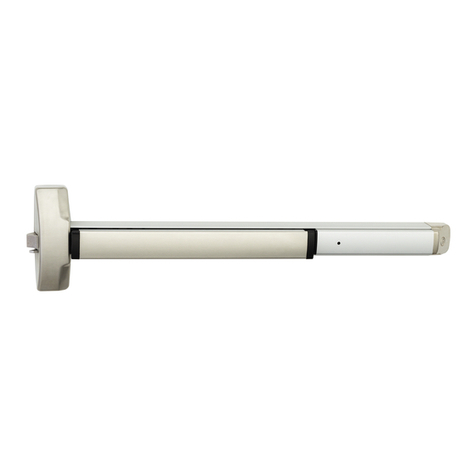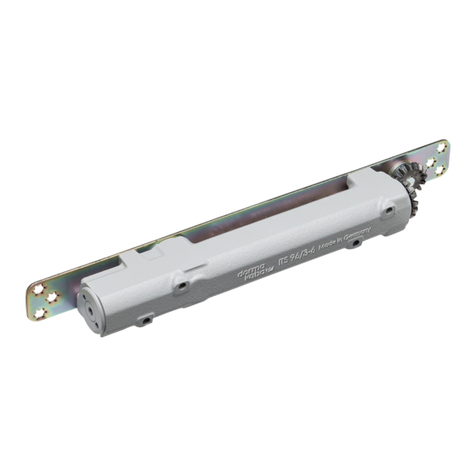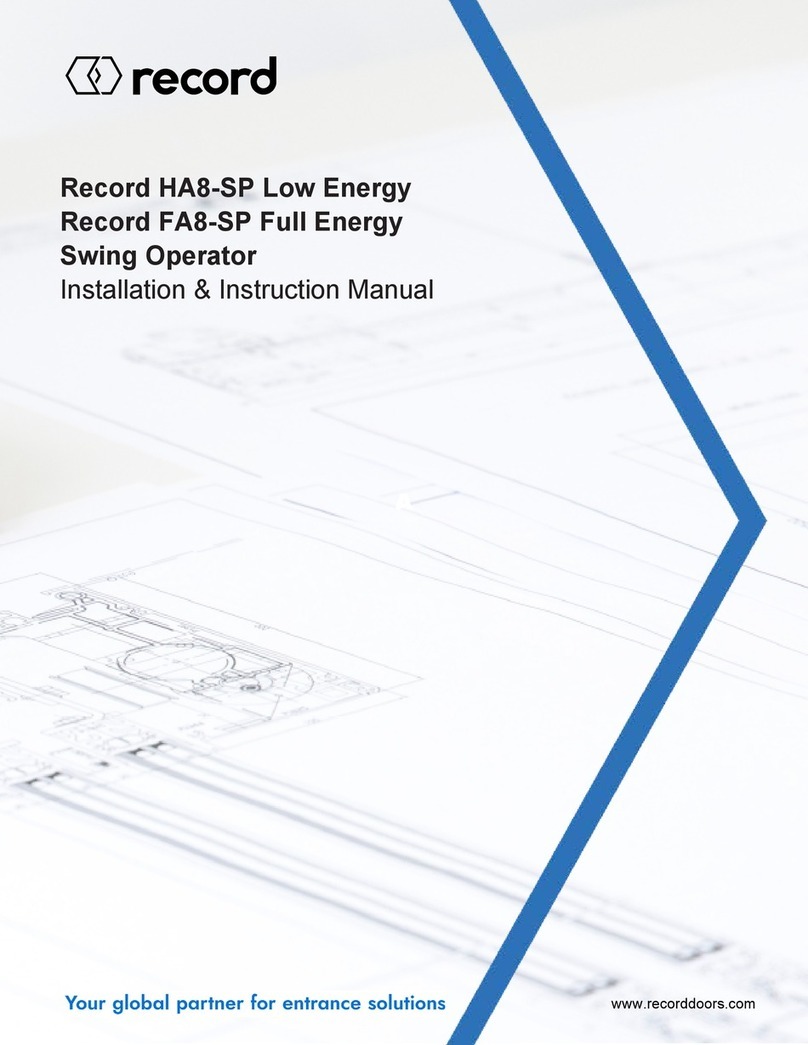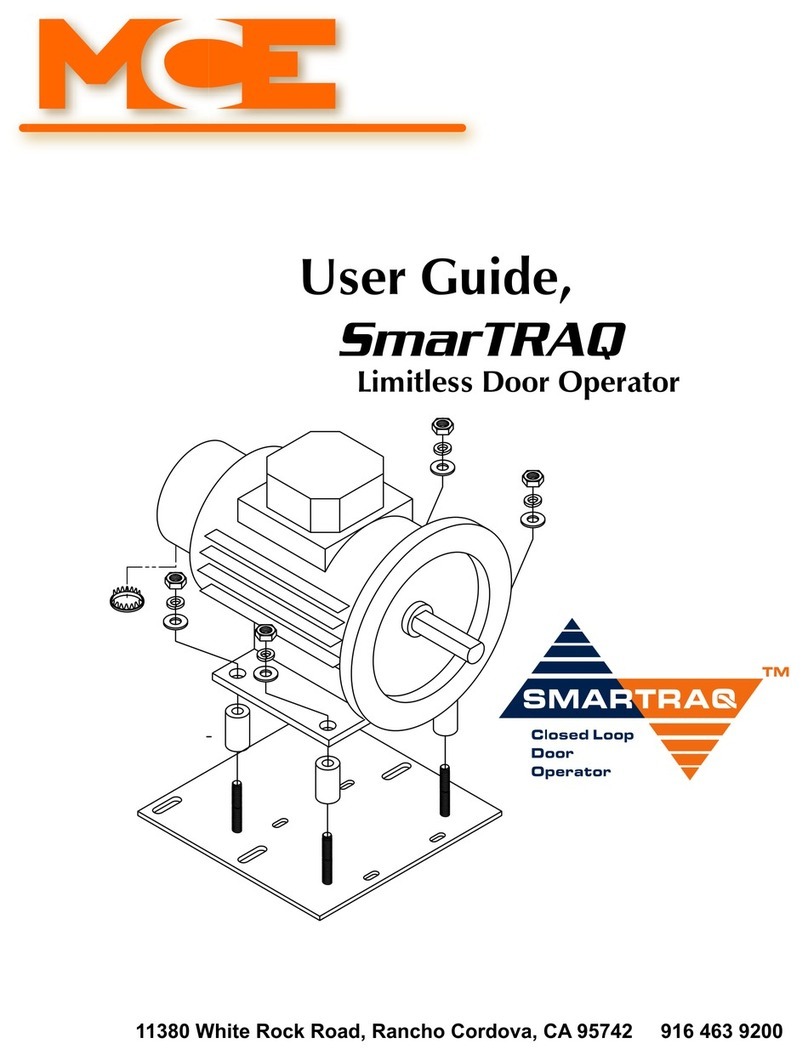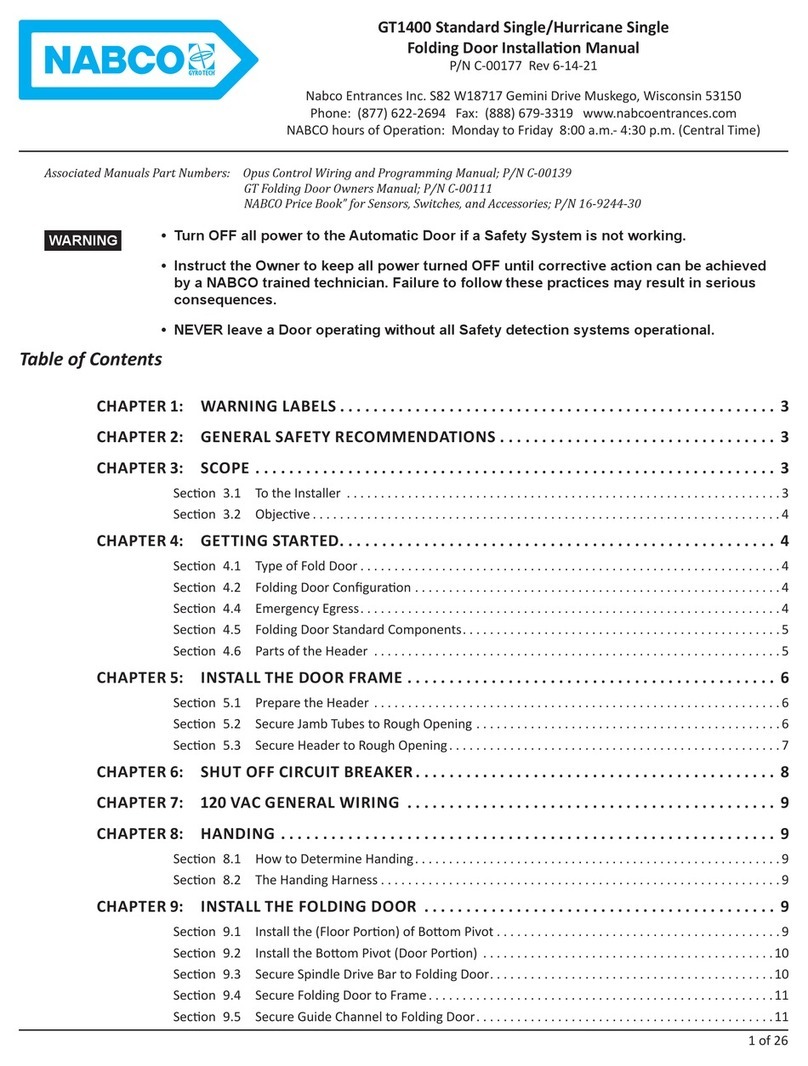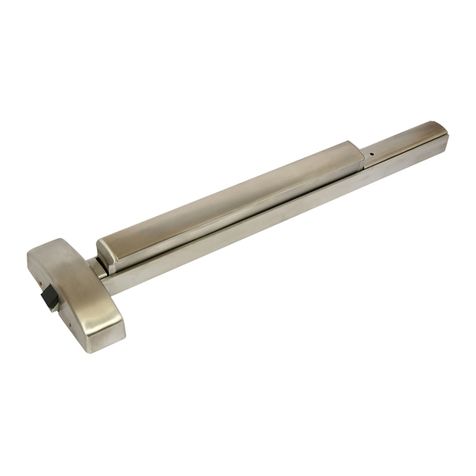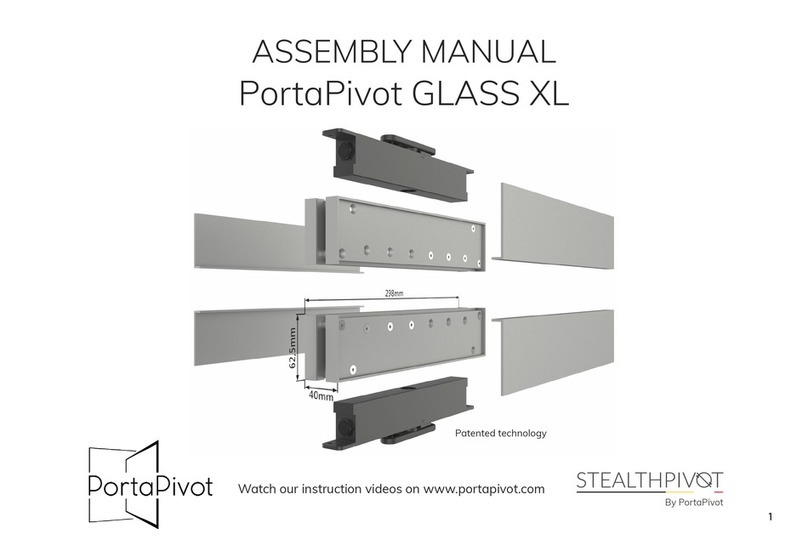Micanan PRO-J Quick guide

INSTALLATION AND INSTRUCTION MANUAL
MODELS: PRO-J, PRO-H
AUG, 2010



2
TABLE OF CONTENTS
PAGE:
VERIFICATION OF OPERATOR AND HARDWARE _____________________________ 3
SPECIFICATIONS ___________________________________________________________ 4
SAFETY INSTRUCTIONS ____________________________________________________ 5
INSTALLATION_____________________________________________________________ 6
ELECTRICAL CONNECTIONS AND SETTINGS________________________________ 9
LIMIT SWITCH ADJUSTMENT _______________________________________________ 23
MICANAN PHOTOBEAM INSTALLATION INSTRUCTIONS_____________________ 24
CLUTCH ADJUSTMENT______________________________________________________ 27
BRAKE ADJUSTMENT_______________________________________________________ 27
EMERGENCY MANUAL OPERATION _________________________________________ 28
OPERATOR MAINTENANCE _________________________________________________ 29
MECHANICAL DRAWINGS AND PARTS LISTS ________________________________ 30
ELECTRICAL DIAGRAMS ___________________________________________________ 34
WARRANTY ________________________________________________________________ 42
OPTIONS
MP00046
#60 Drive Chain and Sprockets
MP00081
Double V-belt reduction
MW00024
Chain Spreader 1” – 1”
MW00025
Chain Spreader 1” – 1-1/4”
MP00040
High Cycle modification
PRO-_W
Waterproof modification
PRO-_4X
Corrosion proof modification
PRO-_X
Explosion proof modification
MP00007 *
115 Volt control circuit
MK00061 **
1.5 sec time delay on reverse
MP00001 **
Timer to Close
PRO-PL
Separate control panel
MP00038
Fire release mechanism
MP00028
Hand Crank
9999999
Pusher Springs
MP00069-74
Auxiliary trolley c/w track & #41 chain
MP00112-118
Dual auxiliary trolley c/w track & #41 chain
MX00001
Floor Level disconnect in lieu of chain keeper
* Not available for logic board controls
** Standard feature with logic board controls
WARNING
DO NOT CONNECT TO ELECTRICAL POWER DURING
INSTALLATIONOR SERVICING OF OPERATOR

3
IMPORTANT
FOR ANY QUESTIONS CONCERNING THE SAFETY OR OPERATION OF THIS OPERATOR PLEASE CONTACT MICANAN
SYSTEMS AT 1-877-888-1116 SAVE THESE INSTRUCTIONS
Upon delivery of your MICANAN SYSTEMS heavy-duty jackshaft door operator, please inspect the unit carefully for damage.
Verify that operator control wiring option, HP, voltage, phase and amperage correspond to available power supply and door
application. Check that along with your operator you have received the following standard hardware.
1 x OPEN/CLOSE/STOP 3-button control station:
1 x #50 Drive chain package : 4’ (1.2m) c/w #50 connecting link
1 x Drive Sprocket 50B12 x 1” c/w 2 set screws and ¼” x 1-1/4” keyway
1 x Door Sprocket 50B18 x 1” c/w 2 set screws and ¼” x 1-1/4” keyway
Note: Sprocket size and bore may vary according to door
size and type, shaft size and drum diameter
1 x Chain keeper
1 x Keyring
4 x 3/8” bolt, hex nut, lock washer and flat washer
1 x pocket wheel hand chain (Model PRO-H) (2 x door height less 4’ (1.2m)
1 x Warning sign
1 set of Micanan photocells (supplied when operator ordered with
interface module or logic board controls)
VERIFICATION OF OPERATOR AND HARDWARE

4
PRO-J and PRO-H heavy-duty jackshaft operators are designed for commercial and industrial high lift, vertical lift, rolling
doors and rolling grilles provided that doors are driven by a drive shaft. Model PRO-H is essentially the same as model PRO-J
with the exception that the PRO-H operator incorporates a chain hoist for manual operation of the door.
STANDARD OPERATOR WEIGHT: 70-95 LBS
MOTOR: Continuous duty 1725 RPM industrial type motor. (Note: 1450 RPM for 50Hz motors)
- Built-in overload protection (3-phase) or separate full overload protection (1-phase).
- Horsepower: 1/3HP, 1/2HP, 3/4HP, 1HP
- Voltage: 115V 1-phase (60Hz) 230V 3-phase (60 Hz) 220V 1-phase (50Hz)
230V 1-phase (60Hz) 460V 3-phase (60Hz) 380V 3-phase (50Hz)
575V 3-phase (60Hz)
REDUCTION: Primary: (5L) V-belt and pulleys (2” to 8” diameter). Secondary: #41 chain and sprockets
OUTPUT SHAFT SPEED: 36 RPM
BRAKE (OPTIONAL):Solenoid actuated drum and brake shoe braking system to prevent coasting and maintain door
position.
WIRING TYPE (3 OPTIONS):
Option 1: Full Feature logic board Smart 10.0 (UL325 (2010) compliant). Note: Micanan compatible primary entrapment
device must be connected for B2, T or TS (momentary or timer activation on close) feature.
Option 2: Relay logic controls with Interface Module (UL325 (2010) compliant). C2 Standard factory wiring (constant
pressure on close, momentary contact on open and stop). If momentary contact on close (B2) wiring is desired,
move “white” wire from terminal #6 to terminal #3. Note: Micanan compatible primary entrapment device must be
connected for B2 (momentary activation on close) or for T (timer to close) feature.
Option 3: Standard relay logic controls (not UL325 2010 compliant, not available in US) C-2 Wiring constant pressure
on close, momentary contact on open and stop. NOTE: If momentary contact on close (B2) wiring is desired, move
“white” wire from terminal #5 to terminal #3.
TRANSFORMER: 24VAC control circuit, supplies power to drive logic board or control relays with 15VA power available for
external devices.
LIMIT ADJUSTMENT: 4 micro switches that control door travel. These limit switches are activated by fully adjustable screw
type cams.
EMERGENCY DISCONNECT: Floor level cable disconnect system with electrical cut-out feature allows person to manually
operate the door by hand (PRO-J) or by chain hoist (PRO-H) in case of emergency.
CLUTCH: Adjustable friction clutch to minimize damage to door operator, door or vehicles when obstruction occurs.
OPERATOR DIMENSIONS:
PRO-J, PRO-H SPECIFICATIONS

5
-READ AND FOLLOW ALL INSTRUCTIONS
-Never allow children to operate or play with door controls. Keep the remote control (where provided) away from children.
-Personnel should keep away from a door in motion and keep the moving door in sight until it is completely closed or opened.
NO ONE SHOULD CROSS THE PATH OF A MOVING DOOR.
-Test the door’s safety features at least once a month. After adjusting the limit of travel, retest the door operator’s safety
features. Failure to adjust the operator properly may cause severe injury or death.
-For products having a manual release, if possible, use the manual release only when the door is closed. Use caution when
using this release when the door is open. Weak or broken springs may cause the door to fall rapidly, causing severe injury or
death.
-KEEP DOORS PROPERLY OPERATING AND BALANCED. See Door Manufacturer’s Owner’s Manual. An improperly operating or
balanced door could cause severe injury or death. Have trained door systems technician make repairs to cables, spring
assemblies, and other hardware.
-Press the “OPEN” device or use emergency disconnect mechanism if a person is trapped under the door.
-SAVE THESE INSTRUCTIONS. The owner or users must understand the safety and operation of door system. Insure that this
installation manual be located close to the door system.
READ AND FOLLOW ALL INSTALLATION INSTRUCTIONS
-Commercial door operators are never to be installed on a residential installation
-Install only on a properly operating and balanced door. A door that is operating improperly could cause severe injury. Have
qualified service personnel make repairs to cables, spring assemblies, and other hardware before installing the operator.
-Remove all pull ropes and remove, or make inoperative, all locks (unless mechanically and/or electrically interlocked to the
power unit) that are connected to the door before installing the operator.
-Install the door operator at least 8 feet or more above the floor if the operator has exposed moving parts.
-Do not connect the operator to the source of power until instructed to do so.
-Locate the control station: (a) within sight of the door, (b) at a minimum height of 5 feet so that small children cannot reach it,
and (c) away from all moving parts of the door.
-Install the Entrapment Warning Placard next to the control station in a prominent location.
-For products having a manual release, instruct the end user on the operation of the manual release.
-Install non-contact entrapment protection devices (photocells) and/or contact entrapment protection devices
(reversing edges). Note: photocells should be installed at no more than 6” from the floor. Edges should be installed on
the leading edge of the door.
IMPORTANT SAFETY INSTRUCTIONS
IMPORTANT INSTALLATION INSTRUCTIONS
WARNING
TO REDUCE THE RISK OF INJURY OR DEATH:
READ AND FOLLOW ALL INSTRUCTIONS

6
Note:
-Installation of operator must be done by a qualified installer. Door must be properly installed and working smoothly.
Remove all door locks prior to installation.
-The PRO-J and PRO-H operators have dual output shafts and may be mounted on left (standard) or right hand side
of door. If handing of operator must be reversed, loosen set screws, remove drive sprocket and keyway and install on
opposite side of drive shaft.
For the PRO-H operator which incorporates a chain hoist mechanism the handing of the operator must be stated at
time of order. Depending on installation, if handing of chain hoist is not correct the hand chain may hang in door
opening. If this is the case, swing chain off to the side and hook it over the top of the door jamb. Do not attempt to
reverse chain hoist on site.
1. Install control station away from all moving door parts, within sight of the door and a minimum of 5 ft (1.5 m) from
the ground.
2. Install entrapment warning sign next to control station.
INSTALLATION INSTRUCTIONS
WARNING
DO NOT INSTALL THIS OPERATOR
BEFORE READING THIS MANUAL CAREFULLY.

7
3. As a general rule, the door operator should be installed below the drive shaft and as close to the door as possible.
The ideal distance between the operator drive shaft and the door shaft is approximately 12” (30cm) to 15” (38cm).
The operator may be wall/bench mounted or bracket /shelf mounted. These two mounting configurations are
shown below:
4. Mount the operator to the wall, hood or bench with 3/8” bolts, nuts and washers provided or with lag bolts and
shields if installation requires it. Make sure that operator is secured but do not tighten bolts.
5. Place door sprocket on door shaft and align with operator drive sprocket but do not insert keyway or set screws.
6. If an optional chain spreader has been ordered with your operator, install as shown below:
7. Install drive chain over sprockets, cut to a suitable length and connect with connecting link.
8. Lower or raise operator to adjust chain tension so that there is no more than ¼” chain slack between sprockets.
Tighten operator mounting bolts.

8
9. Carefully re-align sprockets, if necessary and secure keyway and set screws.
10. (For PRO-H models): Install hand chain by wrapping it through chain guard holes and pocket wheel. Allow chain
to hang down towards floor. Cut chain and connect so that chain is 2’ to 3’ from the floor.
11. Install chain keeper to wall near hand chain at approximately 4’ from floor. Run disconnect chain through keyhole
of chain keeper and cut excess chain links if required. Attach keyring to end of disconnect chain.
12. If an optional floor level disconnect lever was ordered in lieu of the chain keeper, mount to wall with suitable
hardware. Attach both chains together using keyring provided. Allow disconnect chain to be slightly slack when
lever is in the up position.

9
THERE ARE 3 POSSIBLE ELECTRICAL CONTROL CONFIGURATIONS FOR THIS OPERATOR:
A) Standard relay logic controls (not UL325 2010 compliant, not available in US). Refer to Section A for electrical
connections. Refer to electrical drawings inside your operator control box or generic drawings MS100-WW or
MS300-WW in the electrical drawings section at the end of this manual.
B) Relay logic controls with Interface Module (UL325 (2010) compliant. Refer to Section B for electrical
connections. Refer to electrical drawings inside your operator control box or generic drawings MS100-IM-WW or
MS300-IM-WW in the electrical drawings section at the end of this manual.
C) Full Feature logic board Smart 10.0 (UL325 (2010) compliant). Refer to Section C for electrical
Connections and logic board instructions. Refer to electrical drawings inside your operator control box or generic
drawings MSL100-110V-WW, MSL100-220V-WW, MSL300-WW or MSLC300-WW in the electrical drawings
section at the end of this manual.
Refer to electrical diagrams inside control box cover or at the end of this manual prior to connection of power supply or
control station.
WARNING
TO REDUCE THE RISK OF INJURY OR DEATH:
ALL ELECTRICAL CONNECTIONS SHOULD BE MADE BY A QUALIFIED SERVICE PERSON
DO NOT ATTEMPT TO MAKE ELECTRICAL CONNECTIONS TO OPERATOR UNLESS POWER SUPPLY HAS
BEEN DISCONNECTED AT FUSE BOX
OPERATOR MUST BE CONNECTED IN ACCORDANCE TO LOCAL ELECTRICAL CODES AND GROUNDED
TO GREEN GROUND LUG LOCATED INSIDE CONTROL BOX
WARNING
COMPARE AVAILABLE POWER SUPPLY VOLTAGE TO OPERATOR NAMEPLATE PRIOR TO ELECTRICAL
CONNECTION. FAILURE TO CONNECT APPROPRIATE POWER SUPPLY VOLTAGE MAY CAUSE SERIOUS
DAMAGE TO OPERATOR.
ELECTRICAL CONNECTIONS
IMPORTANT
-MICANAN HIGHLY RECOMMENDS THAT EACH INDIVIDUAL COMMERCIAL DOOR OPERATOR
HAVE IT’S OWN DEDICATED POWER SUPPLY
-MICANAN HIGHLY RECOMMENDS THAT EACH INDIVIDUAL COMMERCIAL DOOR OPERATOR
HAVE AN EXTERNAL CIRCUIT BREAKER OR FUSED DISCONNECT

10
SECTION A:PRO-J, PRO-H Standard relay logic controls (not UL325 2010
compliant, not available in US)
POWER WIRING: Use 1-1/8” (2.85 cm) diameter holes for all power wiring.
1. Single phase: Connect single phase power supply to terminals L/L1 (line) and N/L2 on three-pole
power terminal strip.
2. Three-phase: Connect three phase power supply to terminals L1, L2 and L3 on three-pole power
terminal strip.
CONTROL WIRING: Use 7/8” (2.22 cm) diameter holes for all control wiring.
Note: Do not run control wires and power wires in same conduit.
- Install control station within clear sight of door but away from all moving parts of door or hardware.
Install Entrapment warning sign next to control station. Connect 3-button (open/close/stop) push button
station to terminals 2, 3, 4 and 5. Refer to electrical diagram for connection of two 3-button stations.
NOTE: After electrical connections are made, manually move door to mid-position and, using the control station press the
“Open” button for several seconds and then press the “Stop” button. If door did not move in correct direction verify
wiring control station. For 3-phase operators, if door still moves in wrong direction reverse any two of the three
incoming power supply leads to correct rotation.
- Adjust Limit switches as explained in the “Limit switch adjustment section” further in this manual.
CONNECTION OF POWER SUPPLY AND CONTROL STATION
LIMIT SWITCH ADJUSTMENT

11
1. Reversing Edge device (must be normally open contact):
Note: If the door is controlled by any device or wired in such a manner that the door is not controlled by constant
pressure on close then an appropriate reversing edge must be installed.
2. External interlock: Remove jumper between terminals 1 and 2 and wire interlock between these two
terminals.
3. Radio control receiver: Wire standard radio receiver to separate radio strip on side of control box or to terminals 7, 8
and 9 on control terminal strip inside control box.
4. Single button open/close device: Wire to terminals 7 and 8 on control terminal strip.
5. Loop detectors, standard photocells (with a N.O. contact) and other reversing devices: Wire to terminals 3 and 6
on control terminal strip. IMPORTANT: PHOTOCELLS MUST BE MOUNTED NO HIGHER THAN 6” OFF THE FLOOR.
6. 24 Volt power: Wire to terminals 1 and 9 on control terminal strip
CONNECTION OF A REVERSING EDGE DEVICE AND CONTROL ACCESSORIES

12
SECTION B:PRO-J(M), PRO-H(M) Relay logic controls with Interface Module
(UL325 2010 compliant)
Operator electrical connections and start-up instructions
Important: Follow these steps carefully and in the order shown
1) Connect Power supply:
Single phase: Connect single phase power supply to terminals L/L1 and N/L2 on the 3-pole power terminals strip.
3-phase: Connect 3-phase power supply to terminals L1, L2 and L3 on the 3-pole power terminal strip.
2) Connect Push-button station for installation purposes (single phase or 3-phase):
Connect open/close/stop push button station to terminals T2 (stop), T3 (common), T4 (open) and T6 (temporary CP on
close).
3) Verify motor direction:
After the electrical power connections are made and push button station is connected, manually move the door to mid-
position. Press Close button for several seconds and then press stop button. If door did not move in correct direction (or if
limit cams not moving in correct direction towards the close limit switch) see below:
NOTE: THIS OPERATOR COMES WITH AN INTERFACE MODULE INTEGRATED INTO THE CONTROL CIRCUIT.
THE PURPOSE OF THE INTERFACE MODULE IS TO ALLOW FOR FAILSAFE MONITORING OF A MICANAN
COMPATIBLE SAFETY DEVICE AS PER UL 325 (2010) REQUIREMENTS.

13
Single phase operators:The operators leave the factory with correct motor and limit shaft direction according to standard
door installations. However, for special fire door, thru- wall mounting or other special door applications, the motor direction
and limit switch direction may need to be reversed. To reverse the motor rotation, interchange black and white wires going
to motor on the reversing contactor.
3-phase operators: If door moves in wrong direction, turn off incoming power and reverse any two of the three incoming
power supply leads to correct rotation. Press the open button and then activate the open limit to ensure door stops. If door
does not stop, interchange grey and red wires on open and close limits. Interchange white and grey wires on advanced
open and advanced close limits. Remove blue wire from advanced open limit and place it on N.O pin of advanced close
limit.
4) Adjust limit switch cams:
Using the open/close/stop push button station move door to fully closed and fully open oppositions and set limit cams to
correct position. (See Limit adjustment section D further in this manual for complete detail on the end of travel limit
adjustments).
5) Activate Interface module:
After adjusting the open and close limits and verifying the motor rotation, open the door to the full-open position using the
open push button (Figure below on left).
At this point the close pushbutton wire must now be moved from terminal T6 to T5. Now connect the black wire (with blue
label) to terminal T1 as shown in figure below on right.
Note: Ensure the door is in the full open position before connecting the black wire. If door is not in full open position and
monitored photo-eyes or safety edge are not connected and operational then door will immediately move in the open
direction.

14
6) Connect safety devices
Failsafe feature: A monitored failsafe safety feature is built into the operator. The operator has provisions to connect one
primary monitored safety device as well as one or more non-monitored safety device(s).
Primary monitored safety device:
MICANAN monitored failsafe photo beams or MICANAN compatible monitored failsafe devices must be connected to
terminals P1 and P2 if momentary close on pushbutton is required (B2 mode). If not connected, door can only be closed by
constant pressure on close pushbutton. If constant pressure on close pushbutton is removed before door reaches full
closed position, then door reverses to full open.
Note: Only one monitored failsafe safety device can be connected across terminals P1 and P2.
Note: See section E for complete installation instructions for the Micanan N-1 or N-4 photocells.
Secondary non-monitored safety device(s):
A standard 2-wire safety edge, non-monitored reflective or thru-beam photo eye or any other non-monitored reversing
devices with a N.O dry contact can be connected to terminals S1 and S2.
Note: More than one secondary non-monitored safety device can be connected to terminals S1 and S2.
Important: Do not remove resistor that is factory installed across terminals S1 and S2 unless installing a 4-wire electric edge.
4-wire electric edge Connection
A standard 4-wire electric edge can be connected across S1 and S2 terminals as a secondary safety device. Remove the
factory installed resistor across terminals S1 and S2 and install resistor across the black and white pair of wires from the
electric edge and connect the remaining black and white wire to the S1 and S2 terminals.
7) Select Mode of Operation:
C2 mode of operation (momentary on open, constant pressure on close):
The operator is wired at the factory for momentary on open and constant pressure on close. For commercial operators,
white wire is connected to terminal T6.
B2 mode of operation (momentary on open, momentary on close):
If momentary on close is required: For commercial operators, remove the white wire from terminal T6 and place it on
terminal T3.
The operator functions in B2 mode only when the primary monitored safety device is connected and functioning properly. If
it is not connected, operator will go into fault mode and door can only be closed by constant pressure on close and if
constant pressure on close is removed before door reaches full close position, door reverses to full open.

15
SECTION C:PRO-J(E), PRO-H(E) Full feature logic board Smart 10.0 (UL325
2010 compliant)
Note: The operator is shipped from the factory in the D1 mode setting (constant pressure open and close). The operator
should remain in this mode until all connections and limit switch adjustments are completed.
POWER WIRING INSTRUCTIONS:
Connect primary power supply directly to the separate power terminal strip supplied using any of the 1-1/8” (2.85 cm)
diameter holes provided on control box. Do not connect power supply directly to the circuit board.
1. Single phase: Connect single-phase power supply to terminals L/L1 and N/L2 on three-pole power terminal strip
(110V or 220V 1-phase).
2. Three-phase: Connect three-phase power supply to terminals L1, L2 and L3 on three-pole power terminal strip
(208V, 230V, 380V, 460V or 575V).
ON BOARD O/C/S PBS INSTRUCTIONS:
On-board Open, Close and Stop buttons are provided directly on the board for installation and troubleshooting purposes. In
order to operate unit by on-board Open, Close, Stop buttons, the factory installed jumper (#1) between the COM and STOP
terminals on the terminal strip must remain connected.
MOTOR DIRECTION VERIFICATION:
Make sure the mode of operation is selected to D1.
After electrical power connections are made, manually move door to mid-position. Using the on-board buttons press the
“Open” button for several seconds and then press the “Stop” button. If door did not move in correct direction (or if limit
cams not moving in correct direction towards the open limit switch) see below:
For single-phase operators: The operators leave the factory with correct motor and limit shaft direction according to
standard door installations. However, for special fire door, through wall mounting or other special door applications, the
motor direction and limit switch direction may need to be reversed. A dipswitch (Dip #1) is provided to reverse direction of
motor and limit switch direction. If motor direction is reversed, the open and close limit switches are automatically reversed.
However, the advanced close limit switch needs to be manually changed. Disconnect the 2 wires from the advanced closed
limit switch and re-connect to the auxiliary limit switch provided.
Note: Ensure that when the on-board open button is depressed and the door moves in the correct open direction that
activation of the open limit switch illuminates the ‘’OPEN LIMIT” L.E.D and stops the door.

16
For 3-phase operators: If door moves in wrong direction, turn off incoming power and reverse any two of the three
incoming power supply leads to correct rotation. Press the on board open button again. If door is going in the correct open
direction, activate the open limit switch to ensure door stops. If door does not stop, turn off incoming power and
interchange any two incoming power lines once again and slide dipswitch #1 to reverse motor direction. If motor direction
is reversed, the open and close limit switches are automatically reversed. However, the advanced close limit switch needs to
be manually changed. To do this, disconnect the 2 wires from the advanced limit switch and re-connect to the auxiliary limit
switch provided.
Note: Ensure that when the on-board open button is depressed and the door moves in the correct open direction that
activation of the open limit switch illuminates the “OPEN LIMIT’’ L.E.D and stops the door.
LIMIT SWITCH ADJUSTMENTS:
Once the motor rotation and limit cam direction have been verified, adjust the limit cam settings. Please note that when
each limit switch is activated the corresponding LED will light up. Refer to operator installation manual for complete limit
switch adjustment instructions.
CONNECTION OF EXTERNAL O/C/S PBS:
Connect O/C/S PBS as shown in diagram.
Note: Jumper #1 must be removed after the external O/C/S PBS has been installed.
FAILSAFE FEATURE
A safety device failsafe feature is built into the logic board. The logic board has provisions to connect one primary
monitored safety device as well as 1 or more secondary non-monitored safety device(s).
Primary monitored safety device:
MICANAN monitored failsafe photo beams or MICANAN compatible monitored failsafe devices must be connected to
terminals P1 and P2 as primary monitored safety device. Primary monitored safety device must be connected if momentary
activation on close is required in B2, T and TS modes. If it is not connected in B2, T and Ts modes, door can only be closed by
constant pressure on close and if constant pressure is removed before door reaches full close position, door reverses to full
open.
Note: Only one monitored failsafe device can be connected to terminals P1 and P2.

17
Secondary non-monitored safety device(s):
A standard 2-wire safety edge, non-monitored photo beams or any other non-monitored reversing devices with a
N.O contact can be connected to terminals S1 and S2 as secondary non-monitored safety device.
Note: More than one secondary non-monitored safety device can be connected to terminals S1 and S2.
Important: Do not remove the resistor that is factory installed across terminals S1 and S2 unless installing a 4-wire electric
edge.
4-wire electric edge:
A standard 4-wire electric edge can be connected across S1 and S2 terminals as a secondary safety device.
Remove the factory-installed resistor across terminals S1 and S2 when using a 4-wire electric edge
CONNECTION OF EXTERNAL SINGLE-BUTTON DEVICE
Connect an external single-button as shown in diagram. Please refer to ‘’Modes of operation’’ for the functionality of single-
button.
MODES OF OPERATION
All operators leave the factory in the D1 mode setting; please read all modes of Operation and determine which operational
mode is desired
B2: (Momentary on open and close)
• Open Button: Momentary activation opens the door. When door is closing, momentary activation reverses the door (OPEN
OVERRIDE). Momentary contact from mid-stop opens the door to full open position. Constant activation when door is
opening, bypass mid-stop if enabled.
• Close button: Momentary on close.
• Stop button: Momentary activation stops the door.
• Single button device and single channel transmitter, 3-channel (1,2,3) transmitter:
SEQ FUNCTION: Open/Stop/Close/Reverse.
COMMERCIAL FUNCTION: Open/Close/Reverse.
• 3-button O/C/S radio transmitter: Same as open, close, stop buttons.
• Safety Devices: When door is closing, momentary activation reverses the door.
• Timer to close: N/A

18
C2 (Momentary open, constant pressure close)
• Open Button: Momentary activation opens the door. When door is closing, momentary activation reverses the door (OPEN
OVERRIDE). Momentary contact from mid-stop opens the door to full open position. Constant activation when door is
opening, bypass mid-stop if enabled.
• Close button: Constant pressure on close. Door will stop when button is released
• Stop button: Momentary activation stops the door.
• Single button device:
SEQUENTIAL FUNCTION: Open/Stop/Constant pressure on close/stop.
COMMERCIAL FUNCTION: Open/Constant pressure on close/stop.
• Single channel transmitter, 3-channel (1,2,3) transmitter and 3-button O/C/S radio transmitter:
Momentary activation opens the door. Momentary contact of OPEN button on 3-button (O/C/S)
radio transmitter from mid-stop opens the door to full open position. Cannot close the door.
• Safety Devices: When door is closing, momentary activation reverses the door.
• Timer to close: N/A
D1: (Constant pressure on open and close)
• Open Button: Constant pressure opens the door. Door stops when constant pressure is released.
Constant pressure from mid-stop opens the door to full open position.
• Close button: Constant pressure on close. Door will stop when button is released
• Single button device, single channel transmitter, 3-channel (1,2,3) transmitter and 3-button (O/C/S)
radio transmitter: N/A
• Safety Devices: When door is closing, momentary activation reverses the door.
• Timer to close: N/A
E2: (Momentary on open, constant pressure on close with roll-back feature)
• Open Button: Momentary activation opens the door. When door is closing, momentary activation reverses the door.
Momentary contact from mid-stop opens the door to full open position. Constant activation when door is opening, bypass
mid-stop if enabled.
• Close button: Constant pressure on close. Door reverses to full open when button is released.
• Single button:
SEQUENTIAL FUNCTION: Open/Stop/Constant pressure on close/Stop.
COMMERCIAL FUNCTION: Open/Constant pressure on close/Reverse.
• Single channel device, 3-channel (1,2,3) transmitter and 3-button (O/C/S) radio transmitter:
Momentary activation opens the door. Momentary contact of OPEN button on
3-button (open/close/stop) radio transmitter from mid-stop opens the door to full open
position. Cannot close the door.
• Safety Devices: When door is closing, momentary activation reverses the door.
• Timer to close: N/A
T: (Momentary on open and close, timer to close, SAFETY ACTIVATION & STOP BUTTON
DISABLE TIMER)
• Open Button: Momentary activation opens the door. When door is closing, momentary activation reverses the door.
Momentary contact from mid-stop opens the door to full open position. Momentary contact at full-open refreshes the timer
if enabled at full open. Momentary contact at full open position re-activates the timer if timer is disabled previously by stop
button or safety device. Constant activation when door is opening, bypass mid-stop if enabled.
• Close button: Momentary on close.
• Stop button: If door is opening or closing, momentary activation stops the door.
Momentary activation while timer is counting at mid-stop or full open de-activates the timer.
• Single button device, single channel and 3-channel (1,2,3) radio transmitter:
SEQUENTIAL FUNCTION : Open/Stop/Close/Reverse..
COMMERCIAL FUNCTION: Open/Reverse/Refresh timer.
• 3-button (O/C/S) transmitter: Same as open, close, stop buttons.
• Safety Devices: When door is closing, momentary activation reverses the door to full
open AND DISABLES TIMER.
This manual suits for next models
1
Table of contents
Other Micanan Door Opening System manuals
Popular Door Opening System manuals by other brands
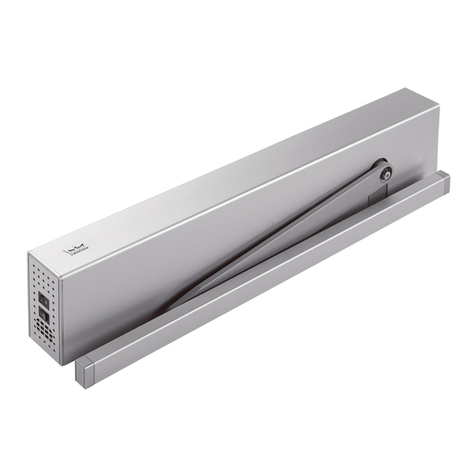
Dormakaba
Dormakaba ED100 user manual
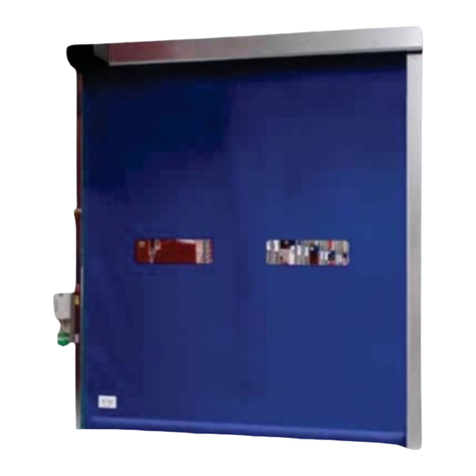
DITEC
DITEC 0DT848 Installation manual, maintenance, use
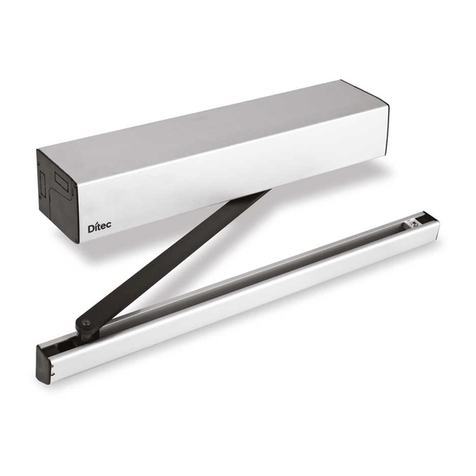
Entrematic
Entrematic Ditec SPRINTSET installation manual
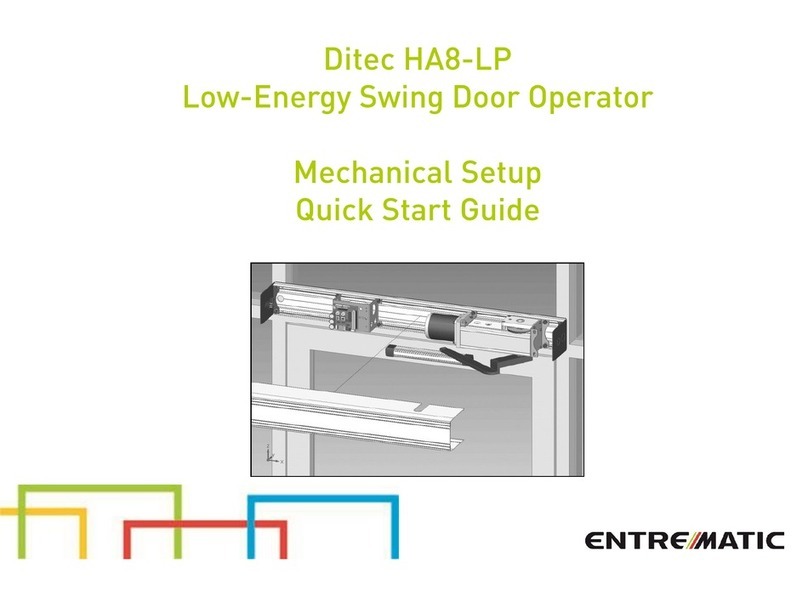
Entrematic
Entrematic Ditec HA8-LP Mechanical installation instructions

Entrematic
Entrematic Ditec DAS107PLUS user manual
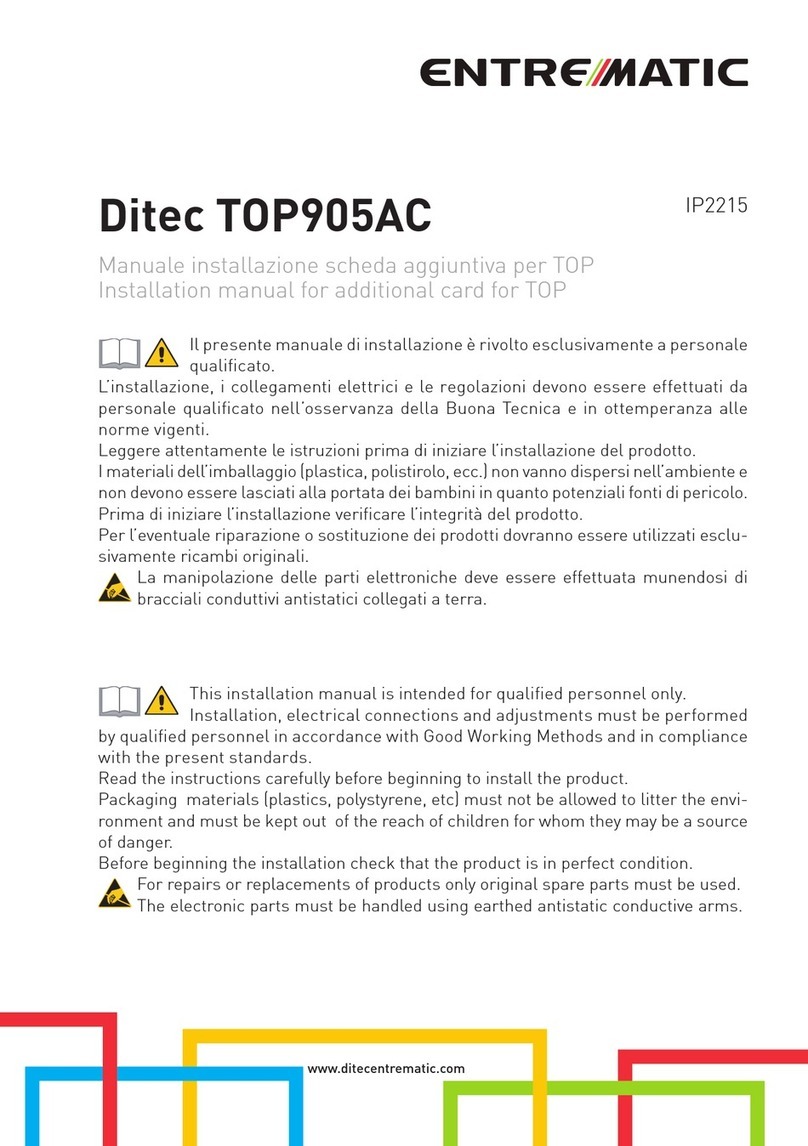
Entrematic
Entrematic Ditec TOP905AC installation manual



